Physical Address
304 North Cardinal St.
Dorchester Center, MA 02124
Fractures that involve the weight-bearing articular surface of the distal tibia are known as pilon or plafond fractures. They were first described by Destot in 1911 and by Bonin in 1950. In 1968, Rüedi et al were the first to describe the fracture, its treatment, and a prognostic classification. These injuries are rare and comprise less than 1% of all lower extremity fractures and between 5% and 10% of tibia fractures. They are distinguished from rotational ankle fractures by the axial loading mechanism resulting in fractures involving the weight-bearing articular surface of the distal tibia. The severity of this injury, the complexity of treatment methods, and the limitations of management still pose a challenge to orthopaedic surgeons.
The articular surface of the distal tibia is an irregularly shaped concave rectangle matching the convex dome of the talus ( Fig. 43-1 ). The surface is wider anteriorly than posteriorly, and it is concave in both the coronal and sagittal planes. The articular cartilage is continuous with the medial malleolar articular surface, which lies at an angle of about 90 degrees to the tibial plafond and extends about 1.5 cm distally. The medial aspect of the distal fibula articulates with the lateral aspect of the talus to complete the ankle mortise ( Fig. 43-2 ). The metaphysis consists of relatively dense cancellous bone surrounded by a thin cortex, with the strongest bone near the subchondral plate.
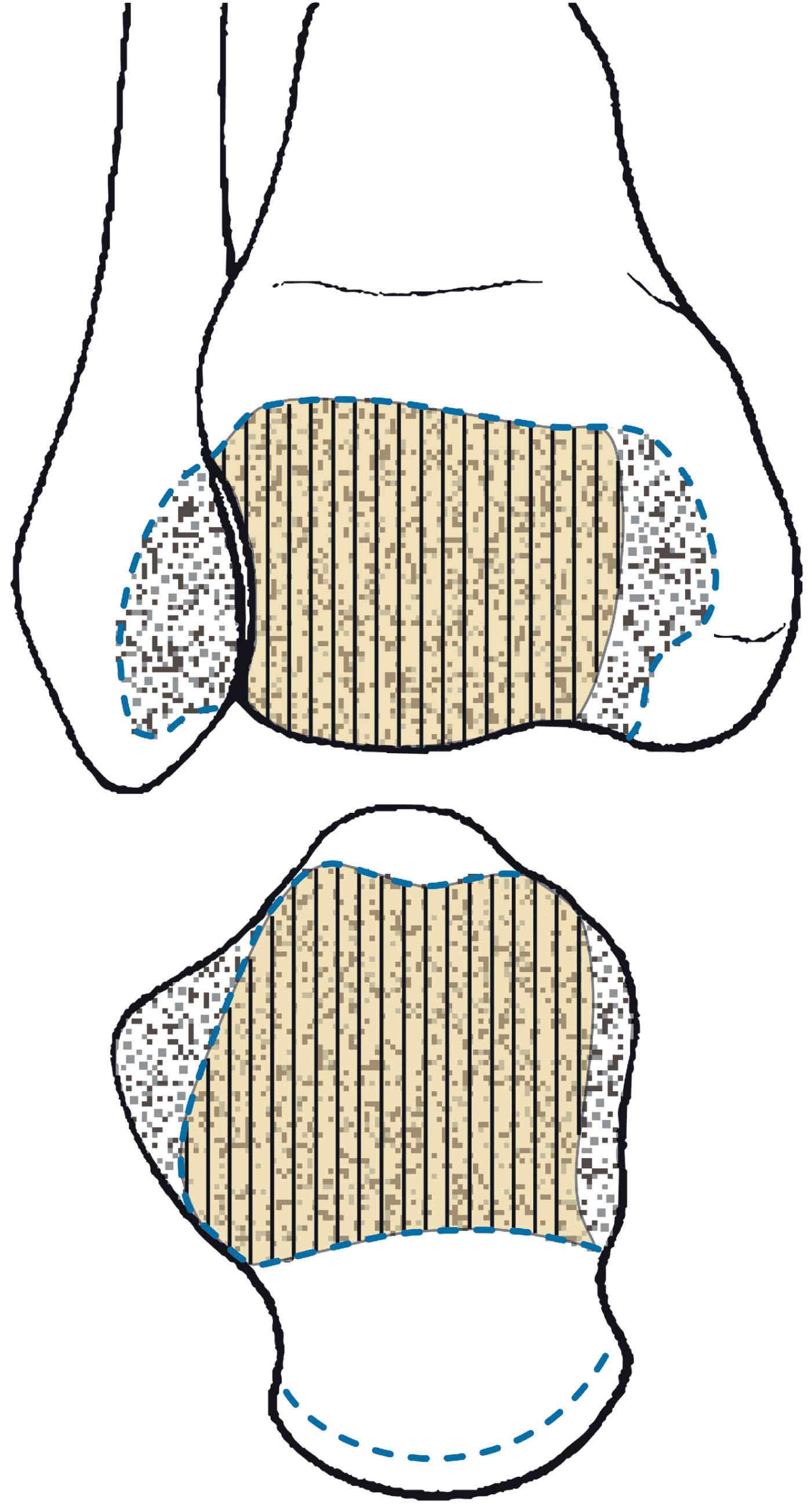
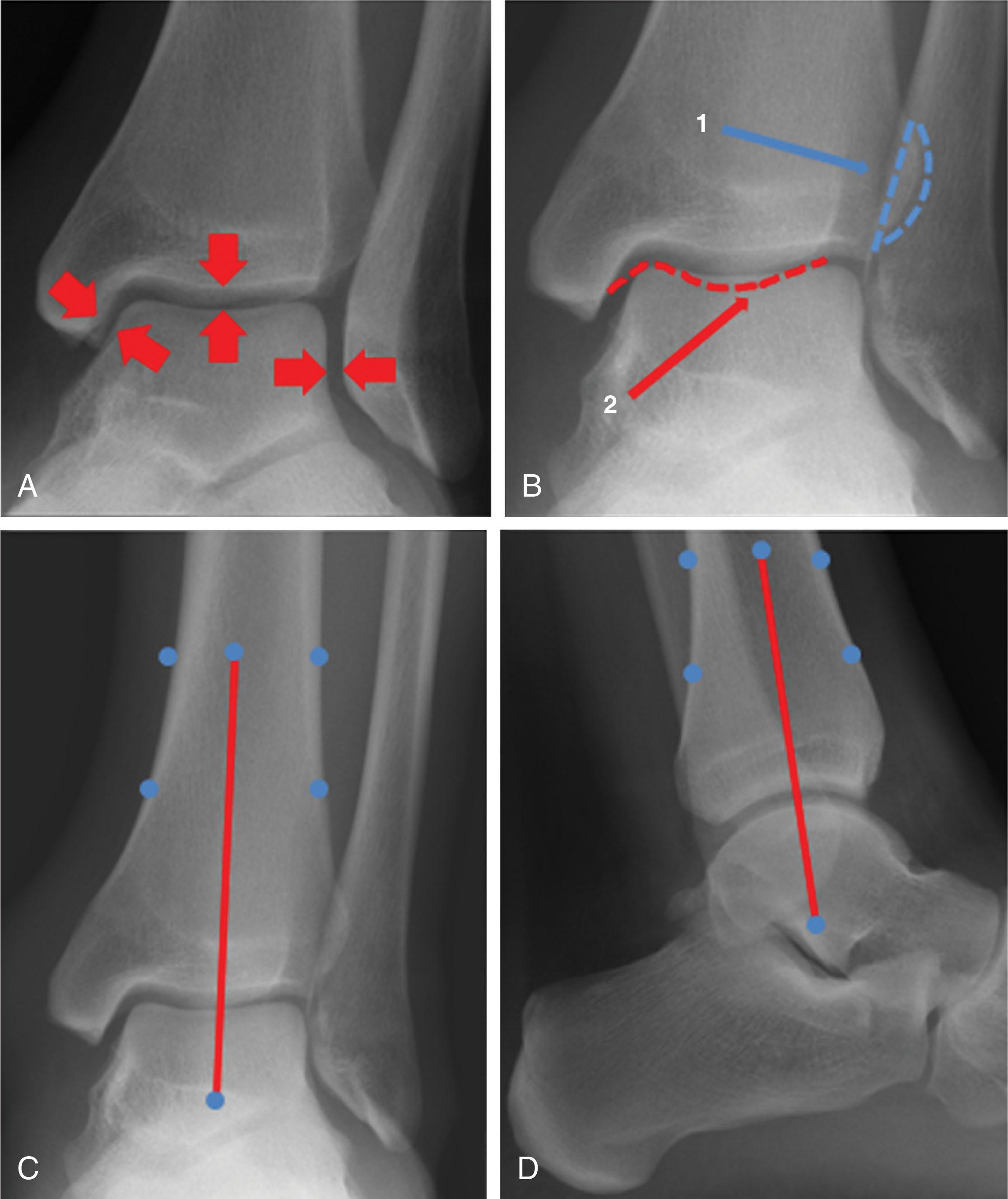
The lateral surface of the distal tibia contains a triangular notch where the tibia and fibula articulate. The anterior tibiofibular ligaments arise from the Chaput tubercle on the anterolateral tibia, anterior to the fibular notch; these ligaments insert on the Wagstaffe tubercle of the distal fibula. The posterior portion of this articulation serves as the attachment for the posterior tibiofibular ligament, whose ligaments are oriented inferior and laterally ( Fig. 43-3 ). The remainder of the syndesmotic complex consists of the strong interosseous ligament, a distal continuation of the interosseous membrane, and the inferior transverse ligament, running deep to the posterior tibiofibular ligament between the tibia and fibula.
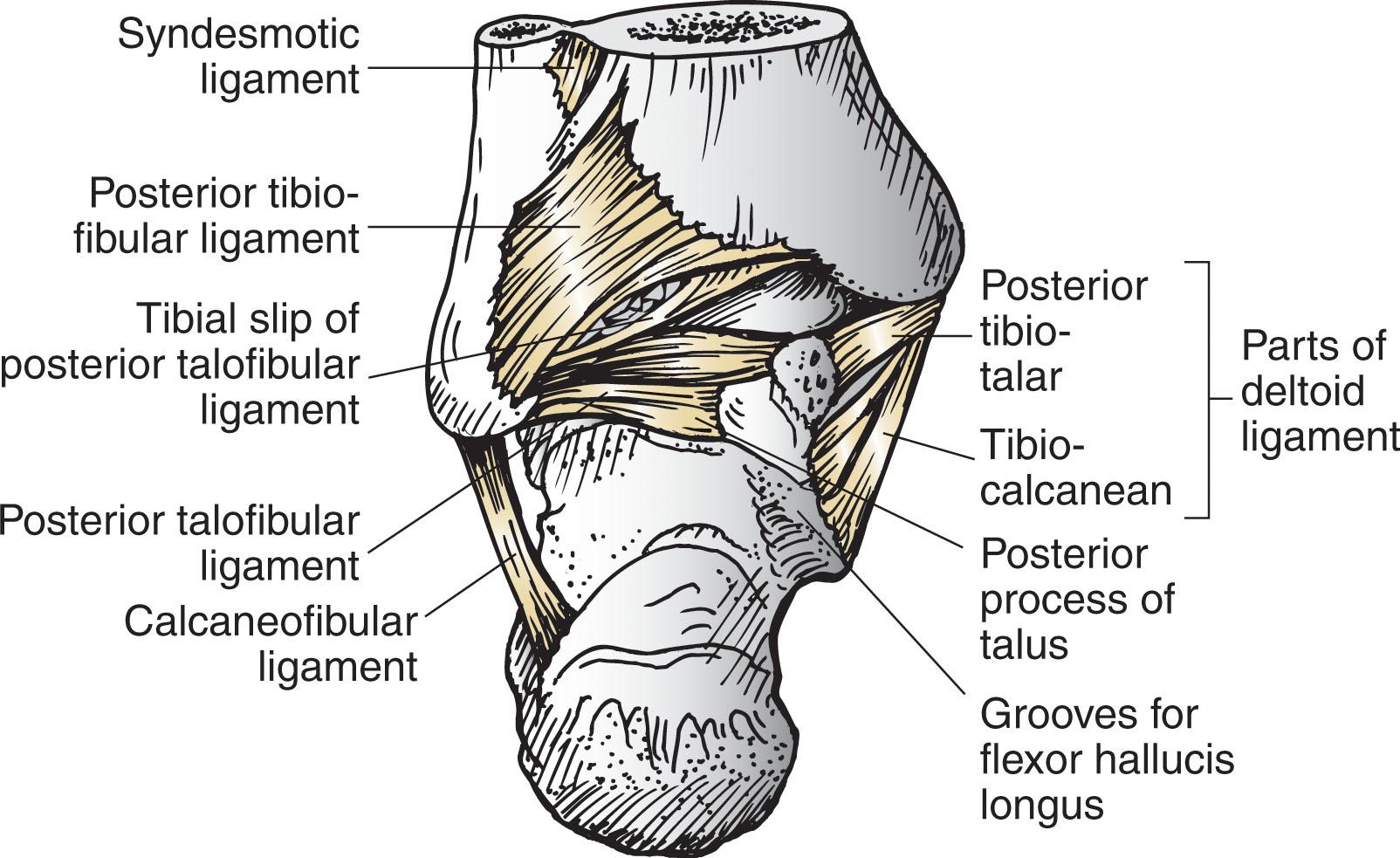
Internal tibial torsion of approximately 25 degrees is seen from the middiaphyseal medial surface of the tibia to the flat surface of the medial malleolus ( Fig. 43-4 ). The anteromedial surface of the distal metaphysis is concave; the radius of curvature of this supramalleolar curve is approximately 20 cm, extending 8 to 12 cm proximal to the medial malleolus.
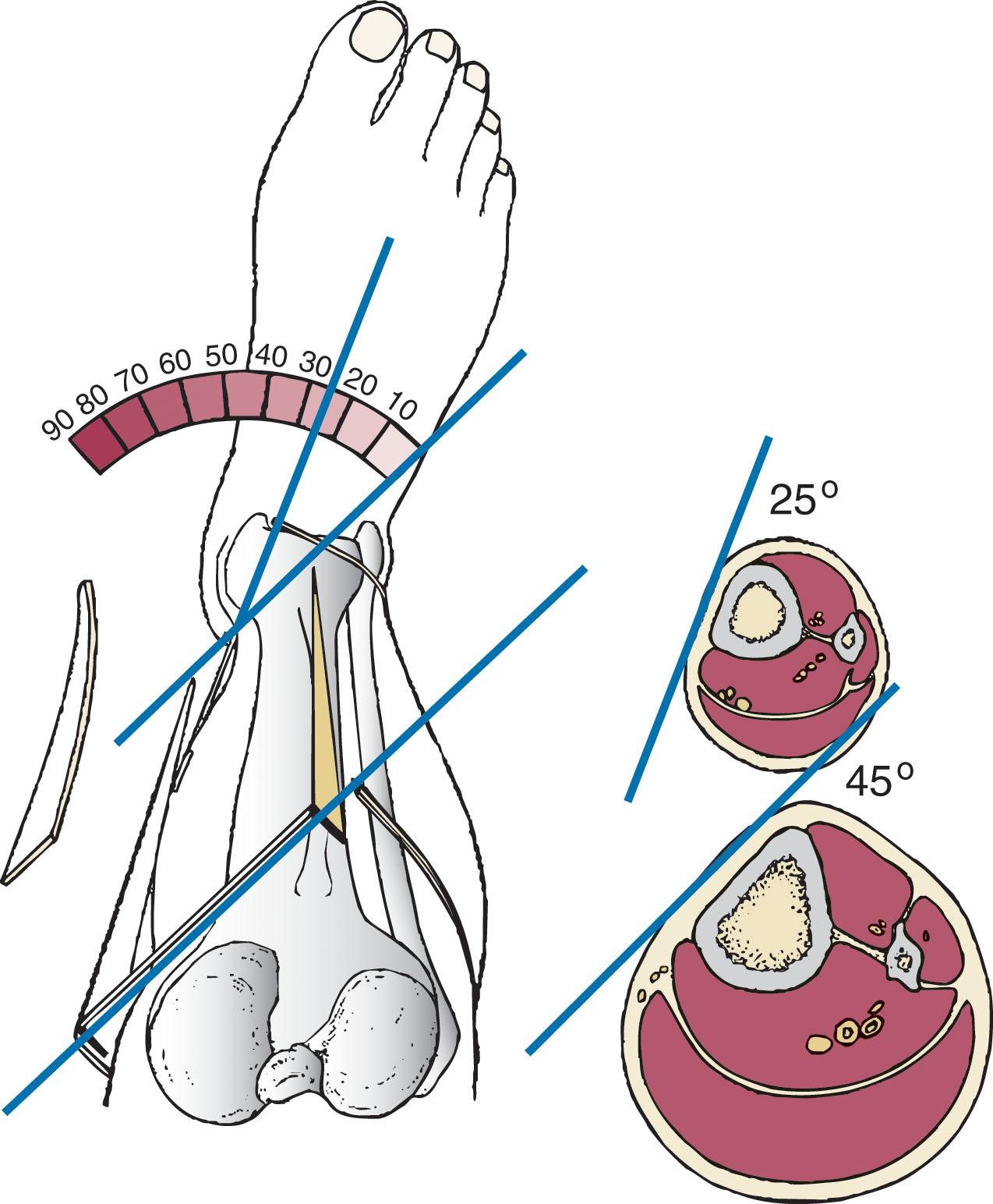
The dorsalis pedis, posterior tibial, and peroneal arteries provide blood supply to the skin covering the distal tibia via perforating arteries originating from the underlying fascia. The extraosseous blood supply nourishes the outer third of the tibial cortex, and the inner two thirds receives its blood supply from the nutrient artery and its medullary branches. The primary branches of the anterior and posterior tibial artery provide the main extraosseous blood supply to the tibia. The superficial venous system of the leg includes the greater saphenous vein, which travels with the saphenous nerve anterior to the medial malleolus up the medial surface of the tibia to the knee. The lesser saphenous vein, the lesser saphenous nerve, and the sural nerve all run posterior to the lateral malleolus, traveling proximally to the center of the posterior aspect of the leg between the medial and lateral heads of the gastrocnemius.
Many authors have speculated on the mechanism of a pilon injury, and many have noted that the position of the foot at the time of impact is critical to the morphology of the fracture. Rüedi et al. was the first to describe in detail the combination of an axially applied load in combination with foot position. If the vertical compression force is applied to a plantigrade foot, a central depression occurs, whereas if the force is applied with the foot in either dorsiflexion or plantar flexion, the fracture results in anterior or posterior malleolar injuries, respectively ( Fig. 43-5 ). Aside from the axial load, additional forces can be created to give each fracture its own personality, including bending, rotational, and shearing forces. These fractures also vary by the amount of energy that they absorb, ranging from high-energy injuries (motor vehicle accidents) to lower-energy injuries (simple fall). The higher the energy of the injury is, the greater the likelihood of comminution, displacement, and cartilage injury.
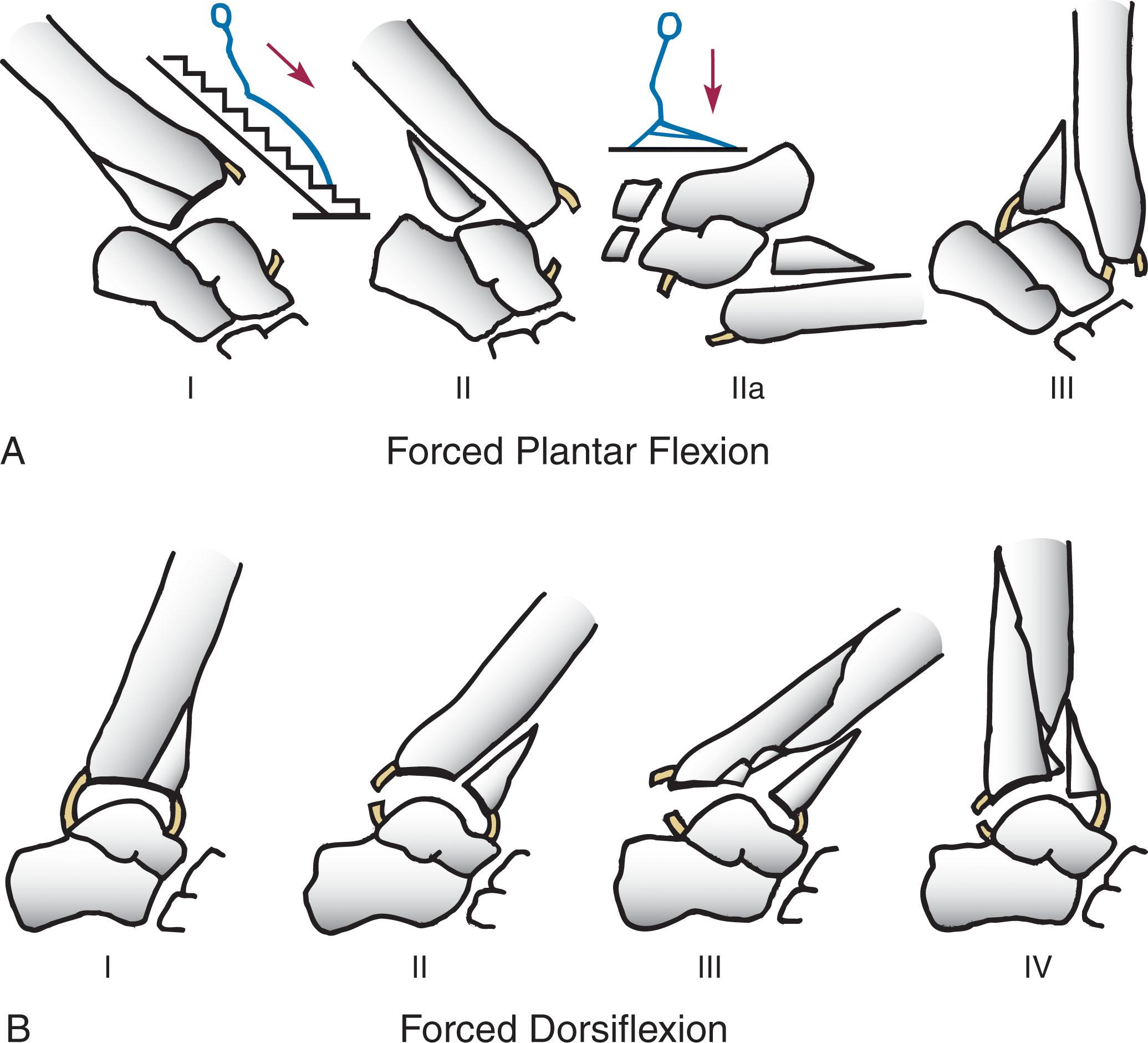
The purpose of a classification system is to predict prognosis based on fracture pattern and to aid the surgeon in selecting a treatment method. It must be reliably assessed and easily communicated for routine clinical use. Unfortunately, despite many attempts over more than half a century, no single classification system meets these criteria. Bohler, Rüedi et al, Kellam and Waddell, and Mast et al have all used plain radiographs to classify pilon fractures. However, none are routinely used in current clinical practice.
Müller et al published the Comprehensive Classification of Fractures (CCF) in an effort to allow surgeons to compare the results of similar fractures. In 1996, the Orthopaedic Trauma Association (OTA) published a similar classification that modified the original Rüedi classification scheme. Tibial plafond fractures are now considered 43-B or 43-C fractures ( Fig. 43-6 ).
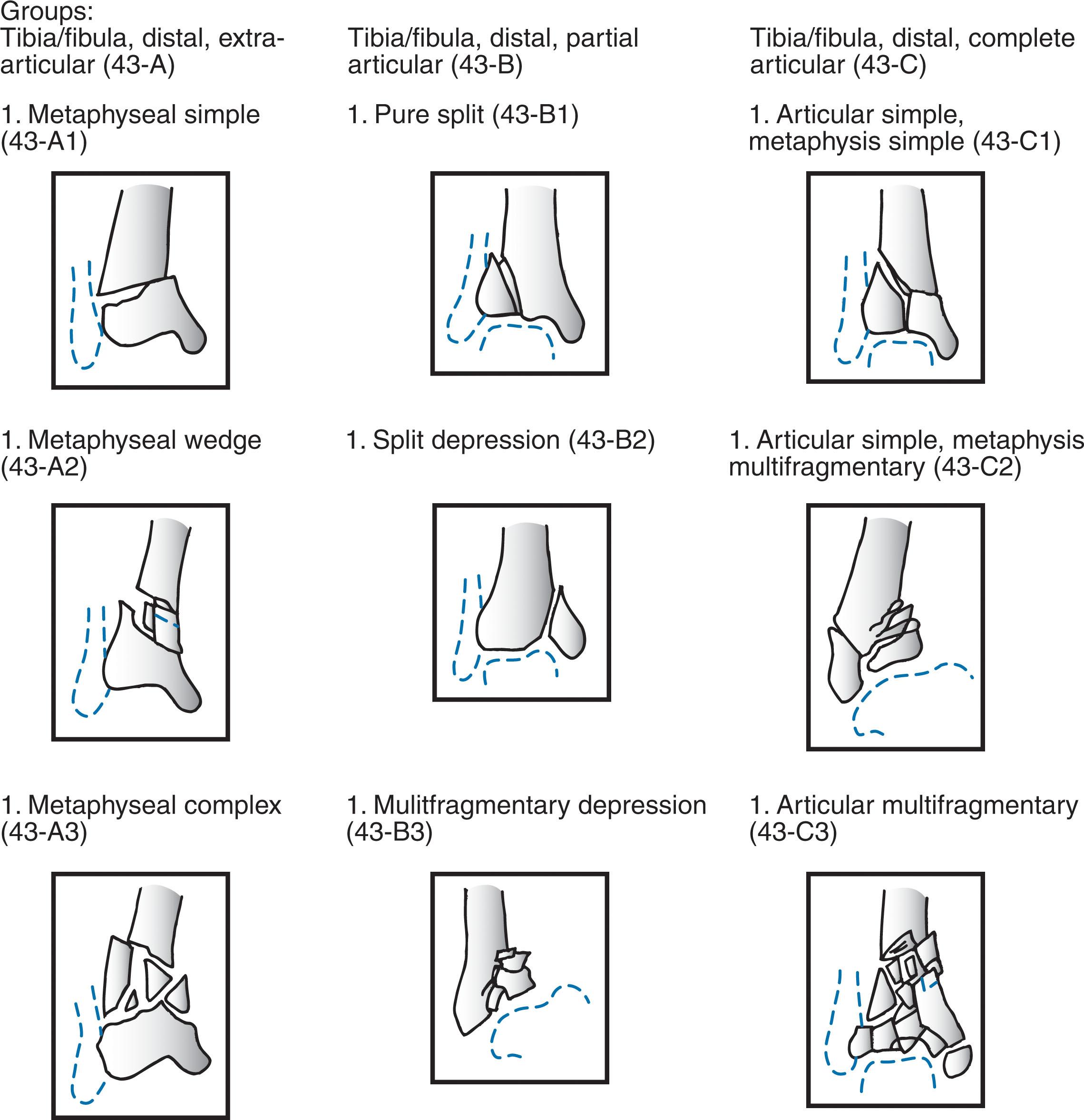
The key distinguishing feature of a B-type fracture is that some portion of the articular surface remains in continuity with the diaphysis ( Fig. 43-7A and B ). This has important implications for determining approach and fixation strategy. In contrast, C-type fractures are intraarticular fractures in which no portion of the articular surface is in continuity with the diaphysis ( Fig. 43-7C and D ). While these categories were designed based on plain x-rays, they are more precisely understood using computed tomography (CT).
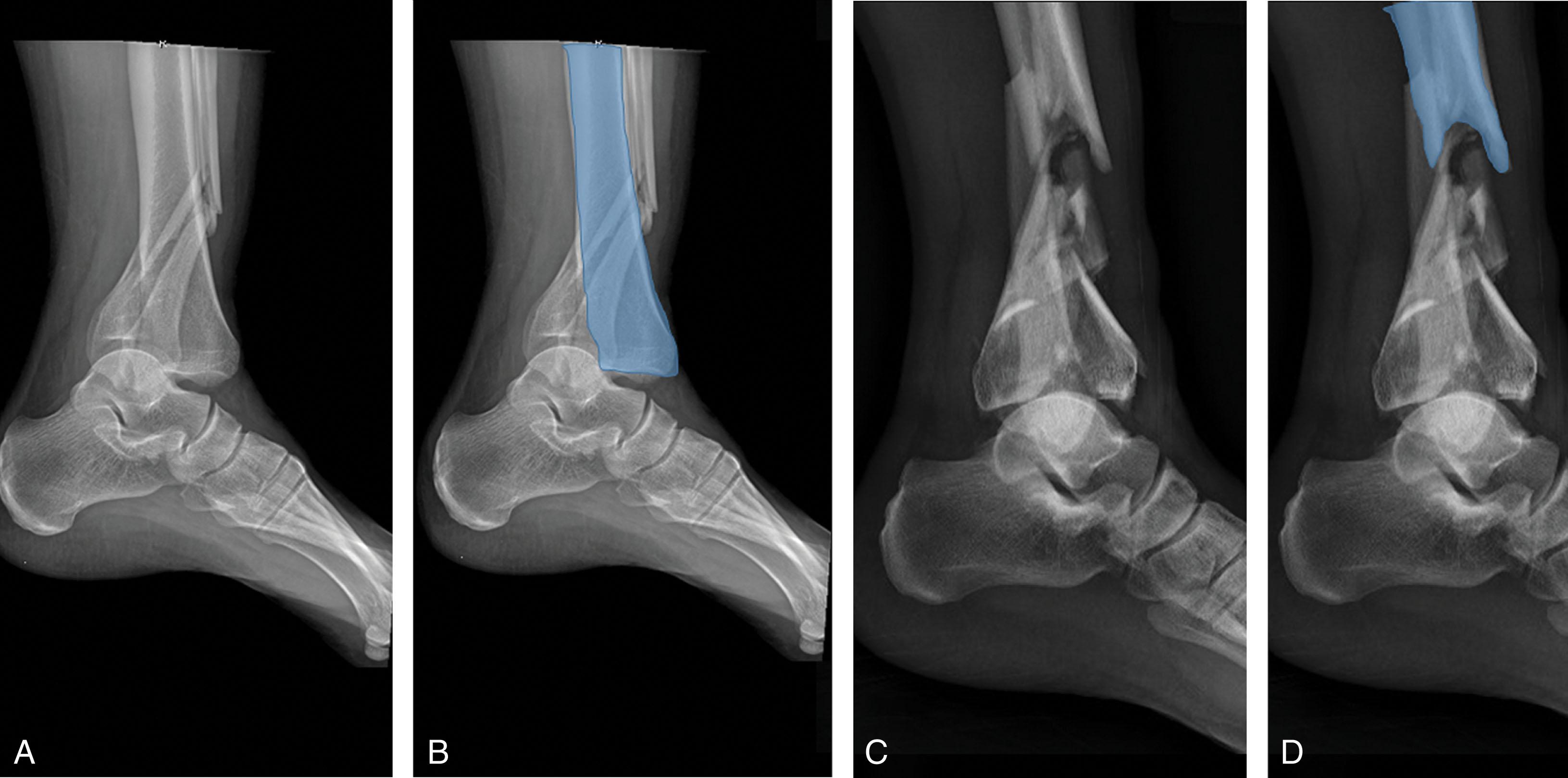
Tornetta and Gorup described the advantages of adding CT imaging to the preoperative planning of these fractures. Using plain films, the authors first classified the fracture according to Rüedi and then reviewed the CT scan to determine whether any further useful information was obtained, specifically the direction of the major fracture line, the degree of comminution, and the amount of impaction. Although a more accurate assessment of the fracture was possible in every case, the most important finding was that the direction of the primary and secondary fracture lines could be more clearly identified. This caused a change in the surgical planning and care in 64% of patients. Subsequently, Topliss et al used CT scans to define the anatomy of the fracture and improve on the classification, but the system is not easily communicated and has not been widely adopted.
Cole et al used CT scans to create a “heat map” of articular fracture lines for C-type fractures. The study highlights the consistent pattern that occurs in C-type fractures with an anterolateral (Chaput), posterolateral (Volkman), and medial malleolar fragment separated by predominantly anteromedial and posteromedial primary fracture lines ( Fig. 43-8 ). The authors also identified locations of articular impaction, which most commonly occurred in the anterior lateral zone. These findings support the use of anterior approaches to address the majority of C-type fractures.
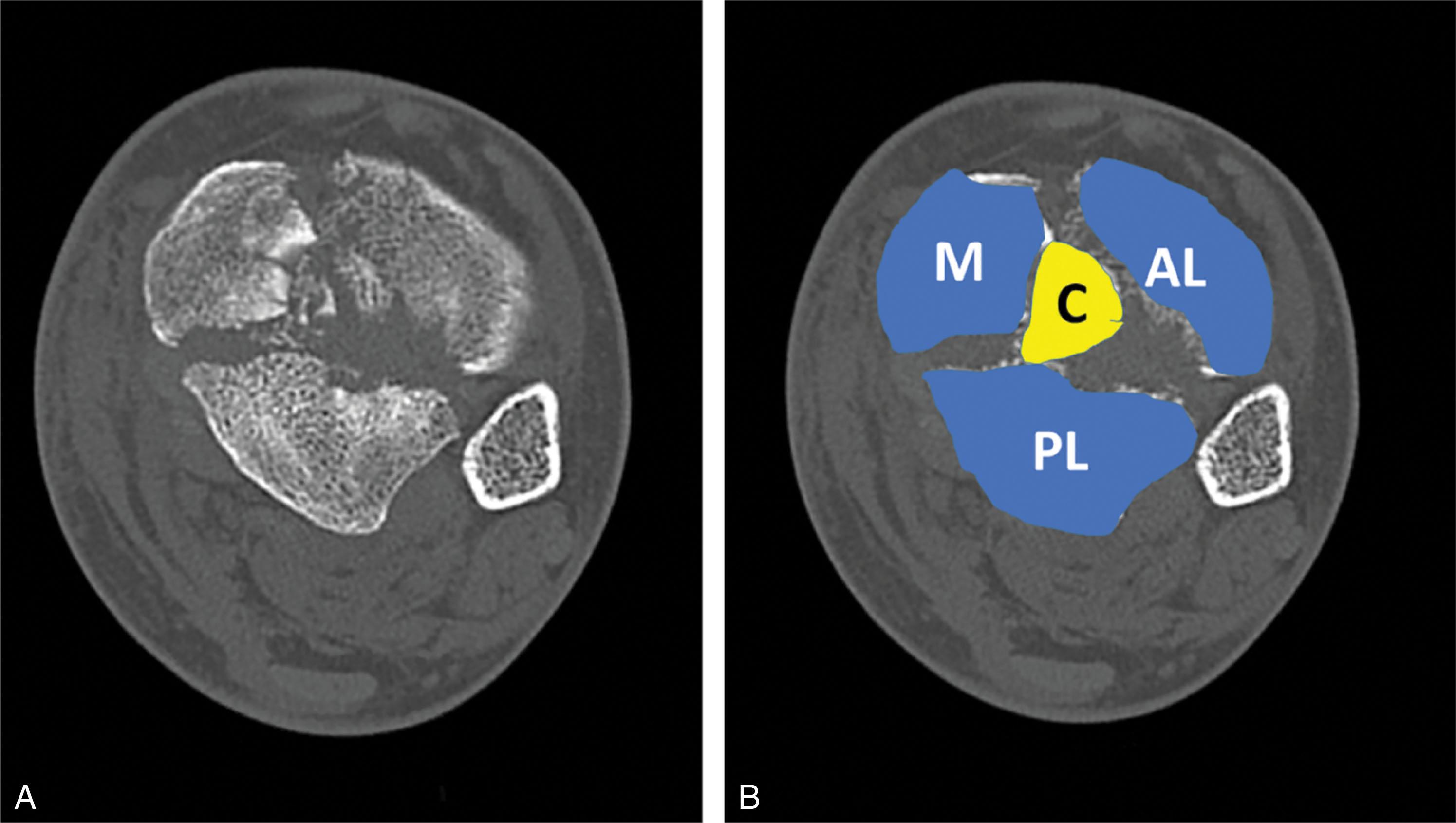
This work evaluating patterns of articular injury by CT was furthered by Labronici et al who assessed the effect of varus or valgus alignment on injury radiographs. Using similar mapping techniques on 73 C-type fractures, the authors found the most common primary fracture exits were anteromedial and posteromedial but that valgus patterns were more likely to have an anterolateral exit and hence a smaller Chaput fragment. The direction of displacement and location of this anterior fracture line exit have important implications for choosing an approach and fixation strategy, which will be discussed further later in the chapter.
Despite the greater understanding of fracture pattern and aid in surgical planning offered by CT, no CT-based classification system developed to date has been widely adopted. For the remainder of this chapter, the Arbeitsgemeinschaft für Osteosynthesefragen (AO)/OTA classification of B- or C-type fracture will be used, along with the consideration of direction displacement of the initial injury.
The diagnosis relies on both clinical and radiographic assessment. The clinical appearance is that of an ankle fracture, which may be either open or closed. Normal orthopaedic protocols should be used for managing the injury in the emergency department. Urgent recognition of a fracture-dislocation of the ankle is essential, and immediate reduction and splinting should be performed to minimize further injury to the soft tissue envelope and articular cartilage. Open fractures are managed with operative debridement and antibiotics.
Initial radiographs, including imaging of the ankle and tibia plus fibula, offer a wealth of information about the fracture. When evaluating these radiographs, the surgeon should determine whether or not the fibula is fractured, the degree of articular comminution, and the amount and location of fragment impaction. Any obvious subluxations or dislocations at the tibiotalar joint, talofibular joint, or the syndesmosis should be noted, as well as any associated injuries to the hindfoot.
CT scans should not routinely be obtained until after the limb has been stabilized (preferably with a spanning external fixator) because the anatomy will be distorted. Once limb length has been restored, the CT scan becomes a useful preoperative planning tool (see Fig. 43-8 ). The CT scan allows the surgeon to better understand the primary fracture planes and location of articular impaction, which are critical for planning subsequent surgical treatment. In the setting of either a low-energy pilon fracture that may be amenable to single-stage treatment, or if limited tibial fixation is being considered in conjunction with external fixation, a preoperative CT scan after closed reduction and splinting should be considered.
Tibial pilon fractures are often the result of high-energy trauma and can be associated with injuries to the ipsilateral or contralateral limb. A thorough evaluation should be performed of the trauma patient, and temporary stabilization of injuries should be performed on initial evaluation. Injuries to the ipsilateral limb, such as tibial shaft or plateau, talus fractures, and calcaneal fractures, may affect the initial treatment by limiting possible temporary fixation sites. Also, these injuries can affect surgical treatment strategies when proceeding with definitive fixation in terms of implant selection and patient positioning.
Due to the impaction mechanism of most tibial pilon fractures, the most common associated injuries are to the talus, including comminuted talar body and neck fractures, all the way to small osteochondral injuries. Although these injuries are relatively infrequent, articular damage, such as delamination or gouging of the talar cartilage, is commonly seen. There is no literature that shows how this affects the long-term prognosis of the ankle joint.
Successful operative treatment for pilon fractures was initially described in the 1950s, mostly for lower-energy rotational injuries of the ankle occurring from ski injuries. Immediate fixation of these injuries, popularized by Rüedi et al, showed good results after 9 years of follow-up in a substantial number of patients.
In 1986, Ovadia and Beals published their results on 145 pilon fractures. The methods of treatment were divided into two groups: open reduction and internal fixation according to the AO technique and other methods. The best results were obtained by open reduction and internal fixation. In their classic 1987 textbook, Schatzker and Tile stated that pilon surgery should be performed soon after the injury, before the development of fracture blisters, incorporating open wounds into the surgical incisions whenever possible. As a result of these publications, internal fixation of these fractures became the standard of care in the United States by the 1990s.
Unfortunately, many fractures in the United States were a result of higher-energy motor vehicle injuries that resulted in soft tissue compromise as well. Many surgeons were also unfamiliar with the soft tissue management techniques needed to obtain a successful operative outcome, and pilon fractures treated with early open reduction internal fixation had high complication rates. In 1992, McFerran et al reported a 40% complication rate when immediate internal fixation was performed, and 21 of 52 fractures required 77 more procedures. Teeny and Wiss reported on 60 plafond fractures, the majority resulting from high-energy mechanisms, treated by internal fixation after 2.5 years, finding poor results occurred in 50% of the cases. The deep infection rate in Rüedi type III fractures was 37%. Of importance, the deep infection rate statistically correlated with the presence of a postoperative wound dehiscence or skin slough but not with the presence of an open fracture.
In response to these high complication rates, less invasive techniques were developed using the techniques of minimal internal and external fixation of tibia fractures. Bone et al presented a series of high-energy pilon fractures treated with articular reduction using isolated lag screws or small plates, combined with external fixation across the ankle to align the metaphyseal components of the fracture, noting a reduced complication rate. Tornetta et al furthered this concept by using isolated lag screws combined with a hybrid fixator so that early motion of the ankle joint could be maintained. The authors concluded that the method offered a low complication rate and had the added advantage of early joint motion. Similar results using this technique were subsequently described by many authors.
Although soft tissue complications were minimized as a result of this technique, unfortunately complications were not eliminated, and hybrid fixation did not seem to solve the problems inherent in severe pilon fractures. Anglen reported on 61 pilon fractures treated by a single surgeon. Fracture stabilization was accomplished with the use of a hybrid external fixator (n = 34) or with internal fixation (n = 27). Patients treated with hybrid fixation had lower clinical scores, slower return to function, a higher rate of complications, more nonunions and malunions, and more infections. Hutson and Zych reported a 7% rate of pin-tract infections, one case of septic arthritis, and one deep infection associated with tensioned wire fixators. When performing a meta-analysis of published data on tensioned wire frames in the treatment of pilon fractures, they noted an overall pin-tract infection rate of 21%. Finally, Vives et al documented the risks associated with tensioned wire placement during frame application, including a 55% rate of piercing of at least one tendon and an 8% to 10% rate of impaling neurovascular structures. Complications after hybrid fixation included malreduction of the articular surface; malunion or nonunion of the tibial shaft; pin-tract, soft tissue, and bone infections; and damage to the neurovascular and tendinous structures about the ankle.
As a result of these complications, consideration was again given to open reduction using plates, but in a staged manner. This concept was not new. Schatzker and Tile noted that in cases of massive swelling “surgery is hazardous and must be avoided” (their italics). They suggested the use of a spanning external fixator and a delay of 7 to 10 days before attempting internal fixation. Similarly, in 1990, Höntzsch et al documented the advantages of two-stage treatment, with a delay in surgical treatment of 2 to 3 weeks in 50 pilon fractures. In February of 1999, two landmark articles, one by Sirken et al and the other by Patterson and Cole, reported on a protocol in which temporary external fixation was used in conjunction with immediate fixation of the fibula, if indicated. Definitive fixation was delayed until the soft tissue envelope had improved, to allow definitive reconstruction, typically between 10 to 14 days. Both studies showed decreased wound complications and improved outcomes for these severe injuries. Staging of the procedure allows the surgeon to stabilize the injury and allows the soft tissues to improve such that soft tissue complications are minimized at the time formal open reduction and internal fixation is performed.
More recently, this technique has been modified to allow partial fixation of the tibial fracture while minimizing soft tissue complications. Dunbar et al described a technique where tibial pilon fragments that had proximal extensions were treated with limited internal fixation through small incisions. The goal of this technique was to convert a C-type complete articular fracture to a B-type partial articular fracture, particularly in fractures with long proximal metaphyseal extensions. This technique of “C to B conversion” creates a stable, reduced posterior column that serves as a starting point for reconstruction of the remainder of the articular surface at the second stage ( Fig. 43-9 ). Ketz and Sanders, reporting on the technique of treating pilon fractures with displaced posterior malleolar fracture fragments using initial limited posterior fixation of the tibia through a posterolateral approach, showed improved overall reductions with no wound complications in 28 patients.
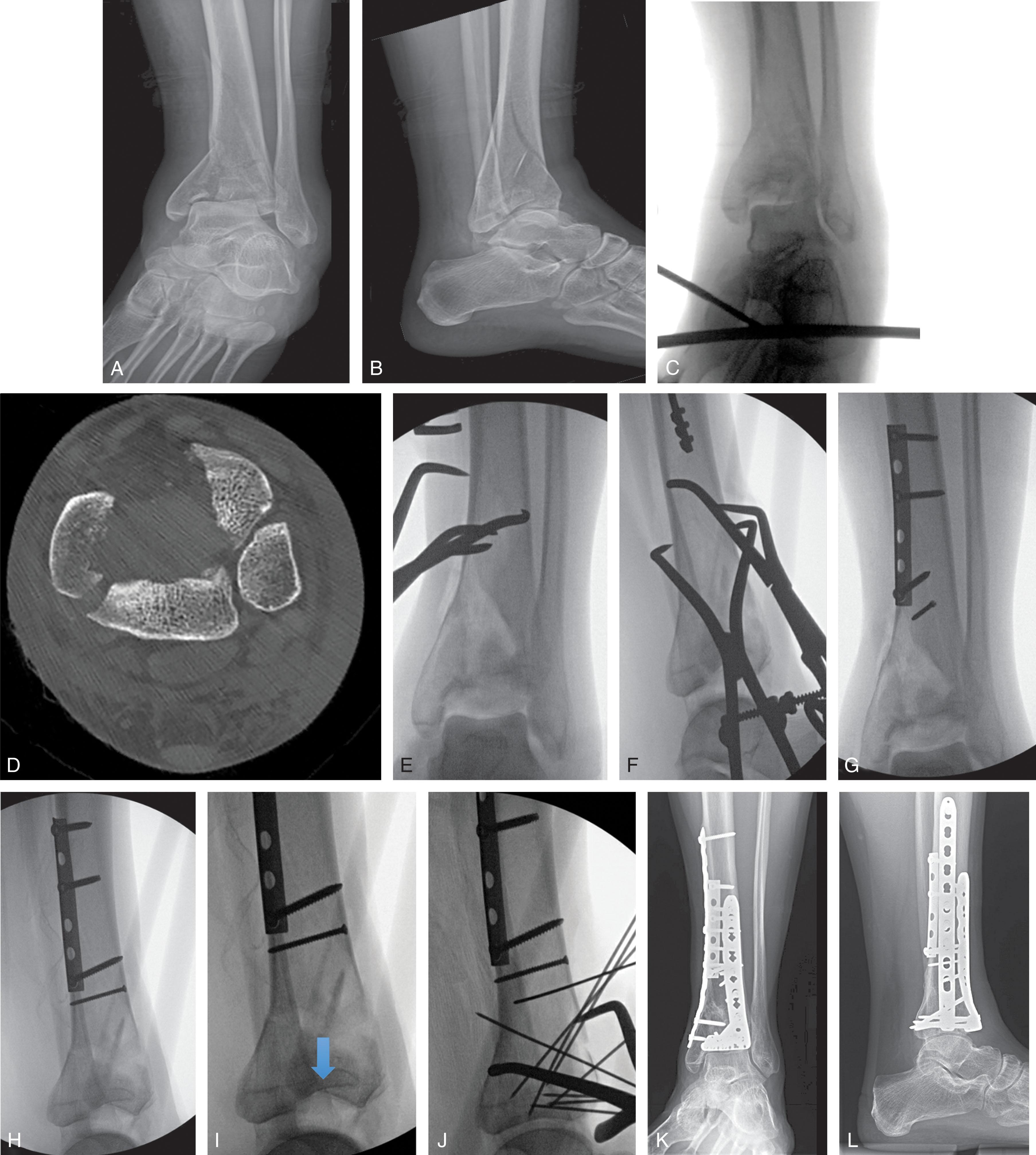
Another technique to reduce wound complications involves percutaneous plating techniques for pilon fractures. Studies using precontoured medial tibial locking plates report low rates of wound complications, but there are a high number of delayed unions or nonunions, with one study having 35% healing after 6 months and a 10% nonunion rate. Hasenboehler et al had 4 of 30 patients heal at greater than 6 months, with one failure of fixation and two nonunions. Low soft tissue complications or infections were seen with both studies. Percutaneous techniques are useful in reducing the soft tissue trauma and remain a viable option for the treatment of pilon fractures, particularly in minimally displaced or nondisplaced fractures. However, there is often poor visualization of the joint, and articular reduction should not be compromised when using these techniques.
Currently, there are numerous treatment strategies for pilon fractures. The “personality” of the individual fracture and the surrounding soft tissues, as well as the patient’s age, function, and comorbidities, dictate which techniques are ideal for a given fracture. Although ring external fixation is still a viable option for definitive treatment, its use has diminished with the adoption of staged internal fixation. The most commonly used approach is staged reconstruction with initial external fixation and delayed definitive fixation. Fibular fixation or limited tibial fixation can also be implemented in the initial stage with relatively low risk of wound complications. Current trends are aimed at fragment-specific fixation with smaller, lower-profile implants and multiple, soft tissue–friendly approaches.
Prior to undertaking external fixation, consideration should be given to whether any component of the fracture is amenable to internal fixation at the first stage. This could consist of either:
Fibular fixation
Limited tibial fixation
Definitive tibial fixation
The decision between these three options is dependent on the status of the soft tissues, the fracture pattern, and whether the surgeon performing the temporizing procedure will also perform the definitive open reduction internal fixation (ORIF). If the surgeon performing the first-stage procedure will not be doing the definitive procedure, it is strongly recommended that internal fixation be avoided at the first stage due to the potential compromise of future surgical plans for the definitive treating surgeon.
The benefit of anatomic fibular fixation at the time of external fixation is restoration of length and rotation of the talus. It also can indirectly reduce tibial fragments resulting from ligamentotaxis ( Fig. 43-10 ). However, it is imperative that the fibular reduction be anatomic because malreduction will severely compromise the ability to achieve anatomic reduction of the tibial plafond. For that reason, early fibular fixation is best suited for cases where there is not severe comminution that would preclude a direct reduction. Indirect techniques are not reliable without an intact tibia to judge length and rotation. While many surgeons are more familiar with the direct lateral approach to the fibula, there are many advantages to a posterolateral approach in the context of a pilon fracture. First, by working through the peroneal fascia rather than directly over the bone, there is tissue for a fascial closure and muscle coverage over the plate, which may make the approach more forgiving from wound healing standpoint ( Fig. 43-11E–G ). Second, the posterolateral approach to the fibula can also be used as a posterolateral approach to the tibia if needed for definitive fixation. Lastly, the posterolateral approach does not preclude the use of an anterolateral approach, which may be important for definitive fixation. Notably, at the time of external fixation the CT scan is typically not available and hence a definitive surgical plan may be unclear. Therefore, the posterolateral approach is very useful in these cases because all approaches that may be desired after reviewing the CT scan will remain available for the second stage. In contrast, a direct lateral approach to the fibula may compromise a posterolateral approach to the fibula and lead to a very narrow skin bridge if an anterolateral approach is subsequently needed.
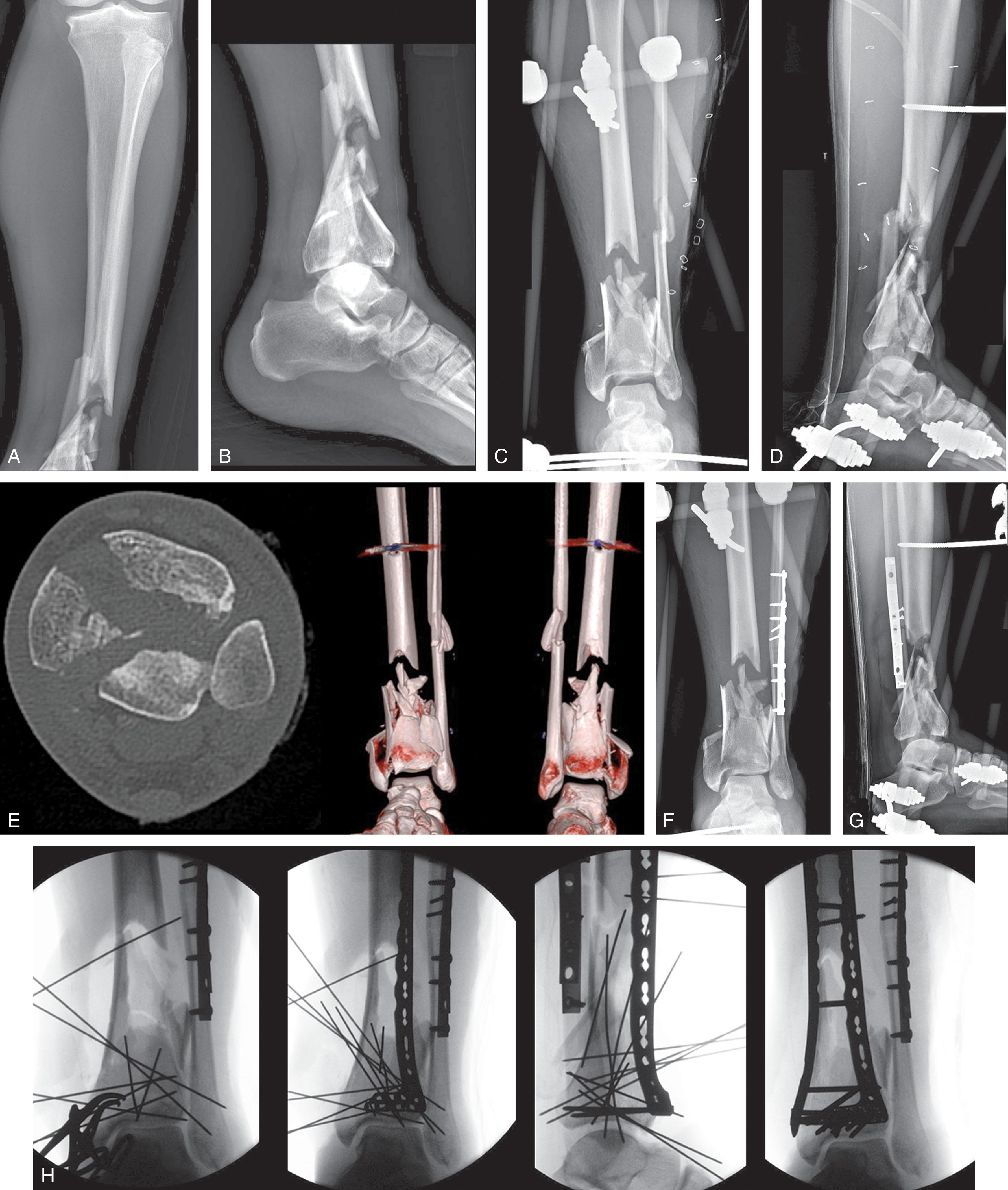
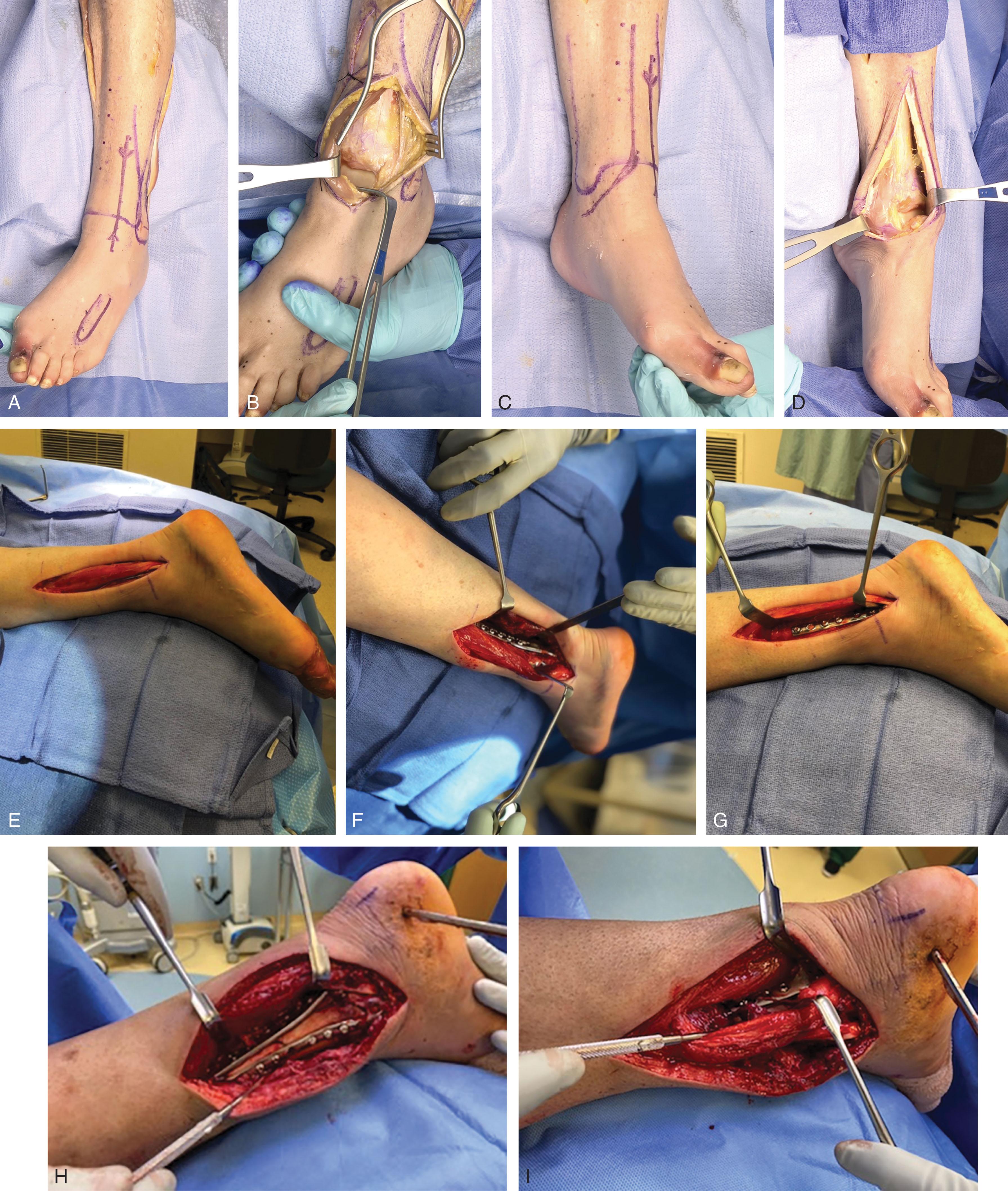
Regardless of the chosen approach, the fibula should almost always be stabilized using a plate and screw construct using direct reduction techniques and absolute stability (see Fig. 43-10F and G ). Because the tibia is not available as a reference for length and rotation, indirect reduction techniques are likely to result in malreduction, which will complicate subsequent tibial reconstruction. For the same rationale, intramedullary fixation using smooth wires or screws, although tempting to minimize exposure, will make it difficult to maintain the length or rotation of the fibula. Although fixation of the fibula is typically performed with external fixation initially, it is important that it be the treating surgeon who performs the fibula reduction and fixation. This will ensure that further incisions or treatment strategies are not compromised because of a previous incision or malreduction from another surgeon.
More recently there has been interest in considering partial tibial fixation at the time of external fixation. There are a few different scenarios where this may be considered. The first is when there is a significantly displaced posterior malleolar fragment with a reliable cortical read to the posterior diaphysis. This was described by Ketz and Sanders, who performed fixation of the posterior malleolar fragment using a posterolateral approach at the time of external fixation, frequently in combination with fibular fixation. While their small series demonstrated good results in terms of articular reduction, this approach does present unique logistical challenges and potential for additional risk of wound healing complications. From a logistical perspective, the CT scan should be performed prior to the first stage surgery. This is important to understand the exact relationship between the posterolateral fragment, the posterior diaphysis, and the medial malleolar fragment, which may be difficult with plain x-rays alone. Like the fibula, a malreduced posterolateral fragment will hinder rather than aid the second stage procedure. Second, the patient is generally placed in a prone position for adequate exposure and fixation of the posterior malleolus. This may create challenges in the application of the external fixation requiring either a change in position or a placing the external fixator in prone position. An alternative strategy is to perform the posterolateral approach as an intermediate stage procedure or at the time of definitive tibial reconstruction.
Two other scenarios may present useful opportunities for limited tibial fixation at the time of external fixation: long diaphyseal extensions and open fractures. Dunbar et al described the use of a limited posteromedial approach for long diaphyseal extensions, which was coined “C to B conversion” (see Fig. 43-9 ). Because the posteromedial approach is relatively proximal over the fracture apex, it does not preclude the subsequent use of either an anterolateral or anteromedial approach. Care must therefore be taken not to extend the approach too far distally, as this will compromise the ability to use an anteromedial approach for the definitive fixation.
Open tibial plafond fractures represent a unique and particularly high risk situation for the treating surgeon. Medial and anterior wounds in particular present a high risk of wound healing complications and infection. While the principles of staged treatment still apply, the initial stage will include a thorough debridement of the traumatic wound in addition to application of external fixation. The placement of implants through the traumatic wound is controversial, but in selected cases there may be benefit to applying low-profile implants through the open fracture wound ( Fig. 43-12 ). This strategy may simplify the definitive procedure and eliminate the need to re-open the traumatic wound at the time of definitive surgery, thereby mitigating the risk of wound healing complciations.
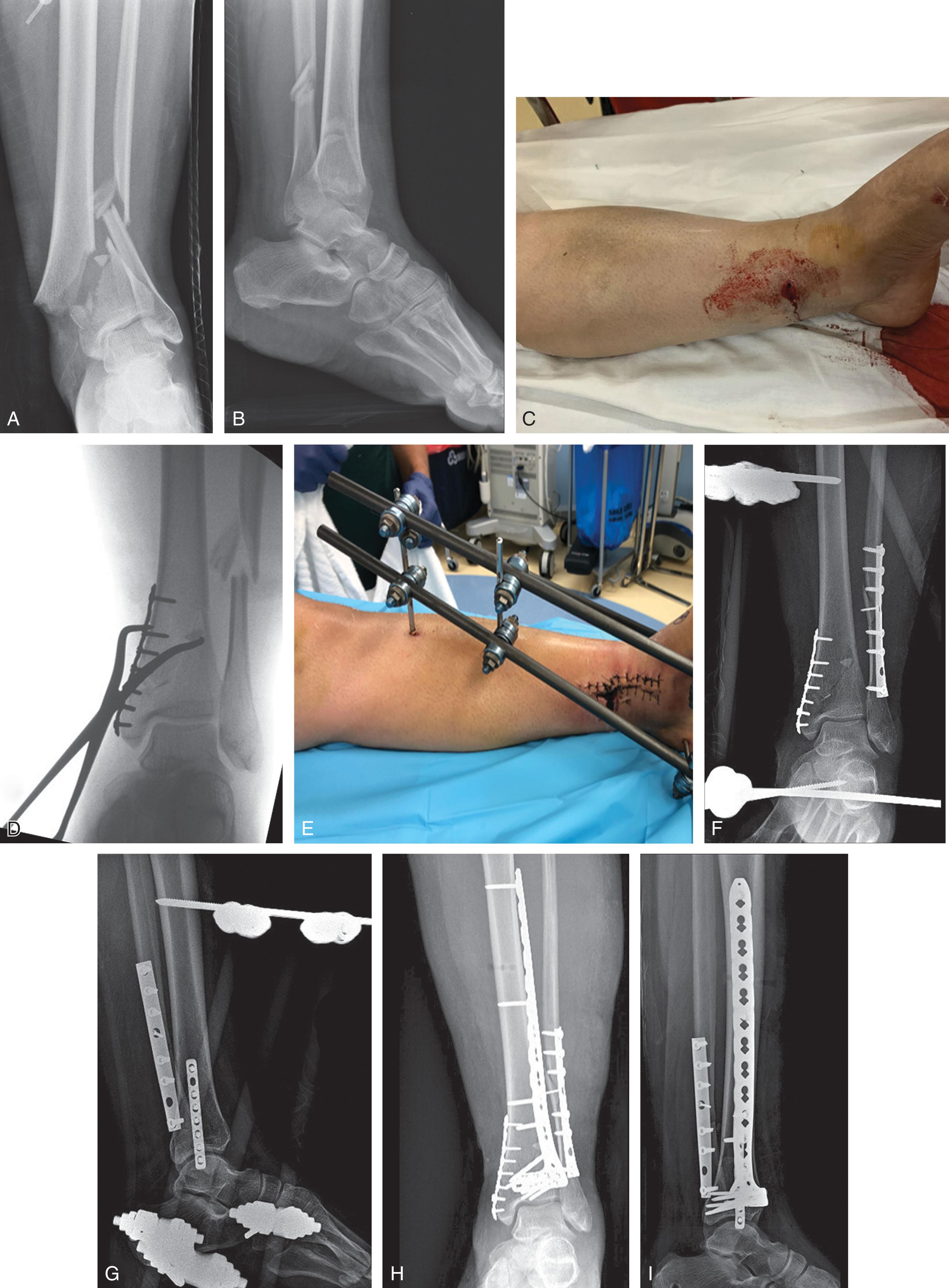
A minority of authors advocate for routine definitive fixation of pilon fractures in a single stage. However, White et al showed results of single-stage treatment comparable to series employing a two-stage approach with the purported benefit of improved fracture reduction as well as the avoidance of the added cost and inconvenience of two surgeries. The key principle of this approach is to treat the fracture as soon as possible after injury prior to the onset of peak swelling. Earlier treatment facilitates reduction because fracture fragments remain freely mobile without organized hematoma and callus, and skin and soft tissue may be more mobile as well. However, the logistical challenge of performing a complex surgery within 24 hours of injury preclude its use in many settings, and hence there are limited data to support the approach outside a single center. Therefore, the routine use of single-stage treatment remains highly controversial and ought to be reserved for experienced surgeons treating low-energy patterns early after injury.
The standard frame used for temporizing a tibial pilon fracture is a delta frame, which is comprised of two tibial pins and a calcaneal transfixion pin connected by medial and lateral bars ( Fig. 43-13 ). This allows for restoration of length and alignment. A midfoot pin is commonly added to maintain a plantigrade foot and improve the stability of the frame. Two broad styles of delta frame are commonly used: a frame employing a multi-pin clamp and a frame using only single pin-to-bar clamps. The advantage of the multi-pin clamp with outriggers is that both tibial pins may be placed first prior to reduction of the fracture. In contrast, if using single pin-to-bar clamps, the reduction should be obtained prior to placing the second tibial pin to avoid creating an overconstrained construct that makes reduction more difficult. By obtaining length and coronal alignment first using the first tibial pin and calcaneal pin, the second tibial pin may be placed strategically to allow for correction of residual deformity, which most commonly occurs in the sagittal plane due to the posterior vector of the medial and lateral bars.
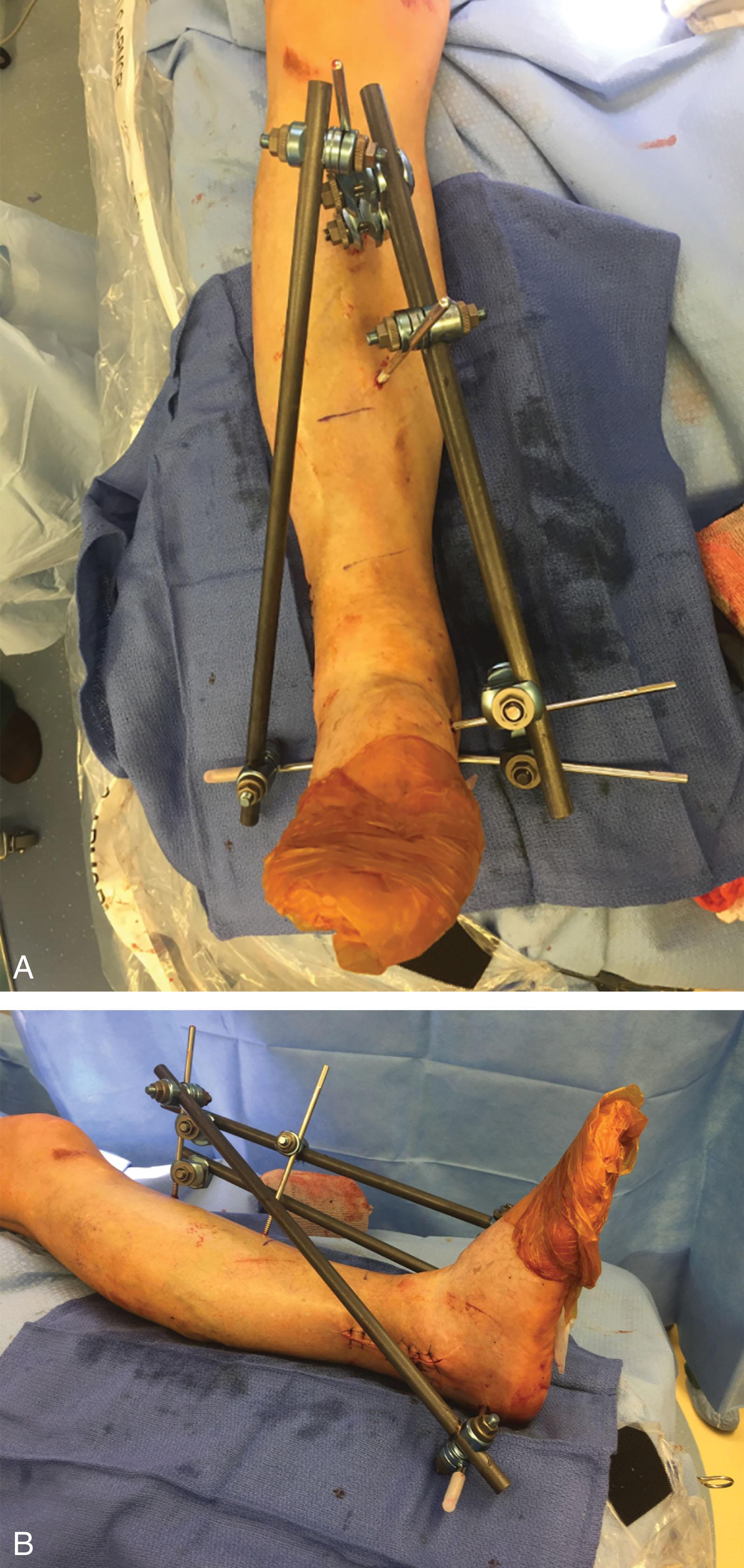
Regardless of the chosen construct, the principles of external fixation for pilon fractures are to create a stable frame with pins placed outside the zone of injury resulting in restoration of length, rotation, and alignment. Whenever possible, pins should be placed such that there will not be overlap with plates used for definitive treatment, which may increase the risk of infection. However, this avoidance of plate overlap should not be justification to compromise the stability of the frame. Anecdotally, plates placed on the anteromedial surface of the tibia are at greatest risk because they will lie directly beneath potentially contaminated external fixator pin sites. Plates on the anterolateral tibia, in contrast, are in a separate compartment from the pin site wound and may be less likely to cause complications even with significant overlap.
Postoperatively, a CT scan should be obtained. Patients can usually be allowed to discharge home with strict instructions to maintain non–weight bearing and elevation above the heart. Management of fracture blisters is controversial, but available evidence supports unroofing the blister to accelerate healing. Definitive treatment can be undertaken when swelling has subsided sufficiently to allow skin wrinkling, and fracture blisters have re-epithelialized.
The choice of surgical approach for definitive fixation is dictated primarily by the fracture pattern but may have to be modified based on status of the soft-tissue envelope and other patient-specific risk factors. Poorly controlled diabetes, peripheral vascular disease, active intravenous drug use, and other comorbid conditions must be carefully considered and may ultimately require an alternative treatment strategy such as casting or definitive external fixation. These alternative methods will likely result in a compromise on reduction quality, but a malunion and posttraumatic arthritis are greatly preferred to an infected nonunion with exposed hardware. Assuming the patient is appropriate for internal fixation, the soft-tissue envelope must be carefully examined. Open traumatic wounds must either be incorporated into approaches or avoided altogether. External fixation should be continued until swelling has sufficiently subsided. Ideally, there should be wrinkling of the skin, but this is ultimately a decision requiring judgement and experience. In cases where multiple approaches are required, adding an additional stage of treatment may be the safest option. For example, a prone posterior approach may be performed 1 to 2 weeks after temporizing external fixation, followed by a third stage anterior approach 1 to 2 weeks after the second stage. In such cases the external fixation is kept in place until after the third stage.
No fracture classification system developed to date is ideal for choosing surgical approach. However, the AO/OTA classification distinction of B- versus C-type fracture is a useful starting point in preoperative planning (see Fig. 43-7 ). The hallmark of a B-type fracture is that some portion of the articular surface remains in continuity with the diaphysis. The fracture can therefore be described based on the location of the fracture apex. For example, a posterior B-type fracture involves the posterior aspect of the plafond with a fracture exiting the posterior cortex, while the anterior articular surface remains in continuity with the diaphysis. The approach in these cases is directed toward the apex of the fracture to allow for direct reduction and application of a buttress plate ( Fig. 43-14 ).
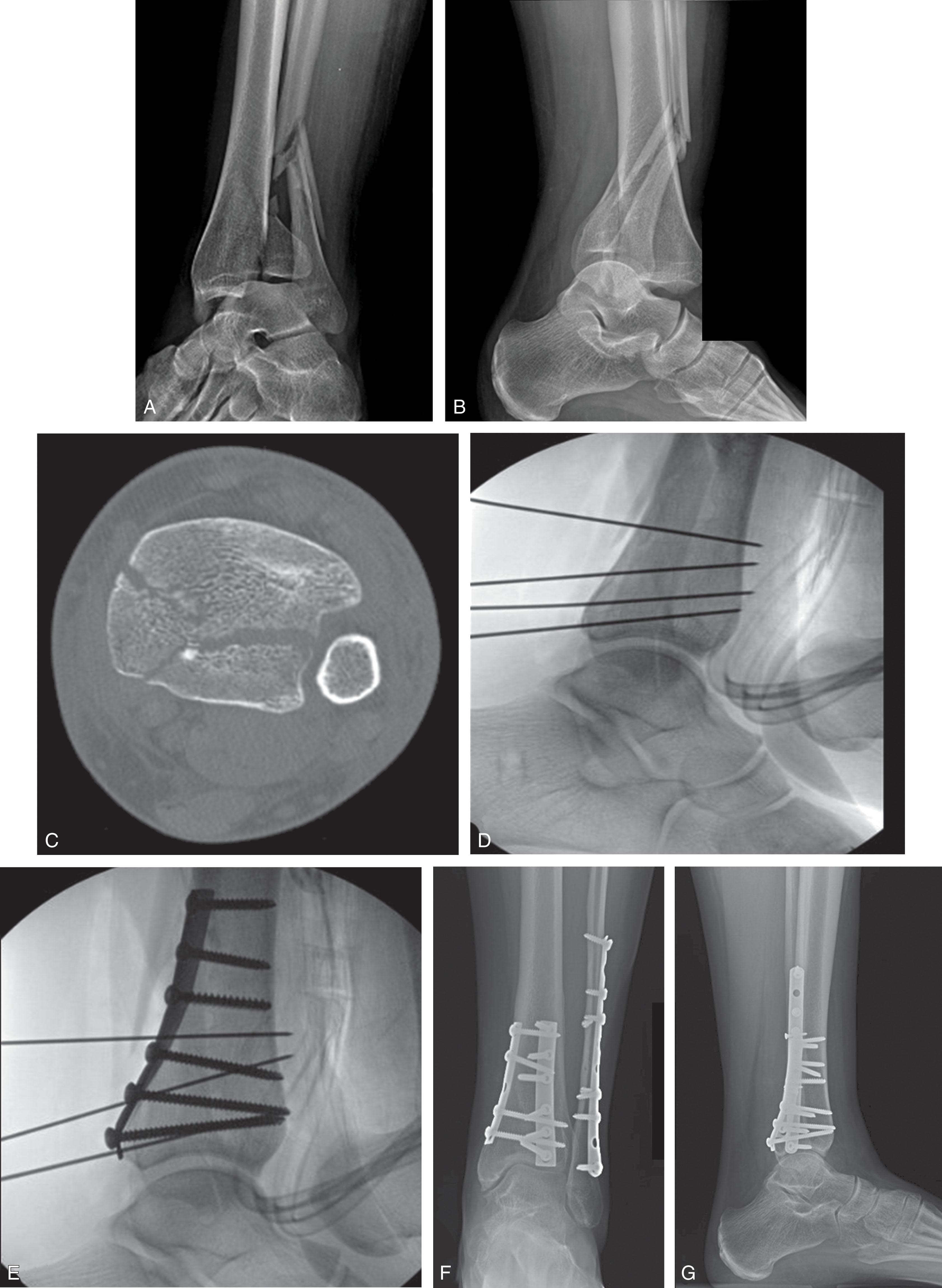
Decision making for C-type complete articular fractures is more nuanced. Assuming soft tissues are not an obstacle, nearly all C-type fractures will require an anterior approach, either anteromedial or anterolateral. Unlike the posterior approaches, the anterior approaches allow for direct visualization of the articular surface, which is critical for accurate reduction. This is further aided by external rotation of the Chaput fragment on the syndesmotic ligaments, which will “book open” the fracture and allow access to central impaction. The decision of anteromedial or anterolateral approach is largely driven by the location of the anterior fracture line exit between the medial malleolar and Chaput fragments (see Fig. 43-8 ). A more medial exit, which implies a larger Chaput fragment, will be best addressed using an anteromedial approach (see Fig. 43-10 ). In contrast, a lateral fracture exit, which implies a smaller Chaput fragment, is most easily addressed using an anterolateral approach ( Fig. 43-15 ). A key point is that the choice of approach is not driven by the choice of fixation . A plate designed for the anterolateral distal tibia may be placed through either an anteromedial or anterolateral approach. Similarly, a medial distal tibia plate can be placed through an anteromedial incision or through a separate medial incision in the case of an anterolateral approach. The choice of approach is dictated by the reduction strategy rather than choice of fixation .
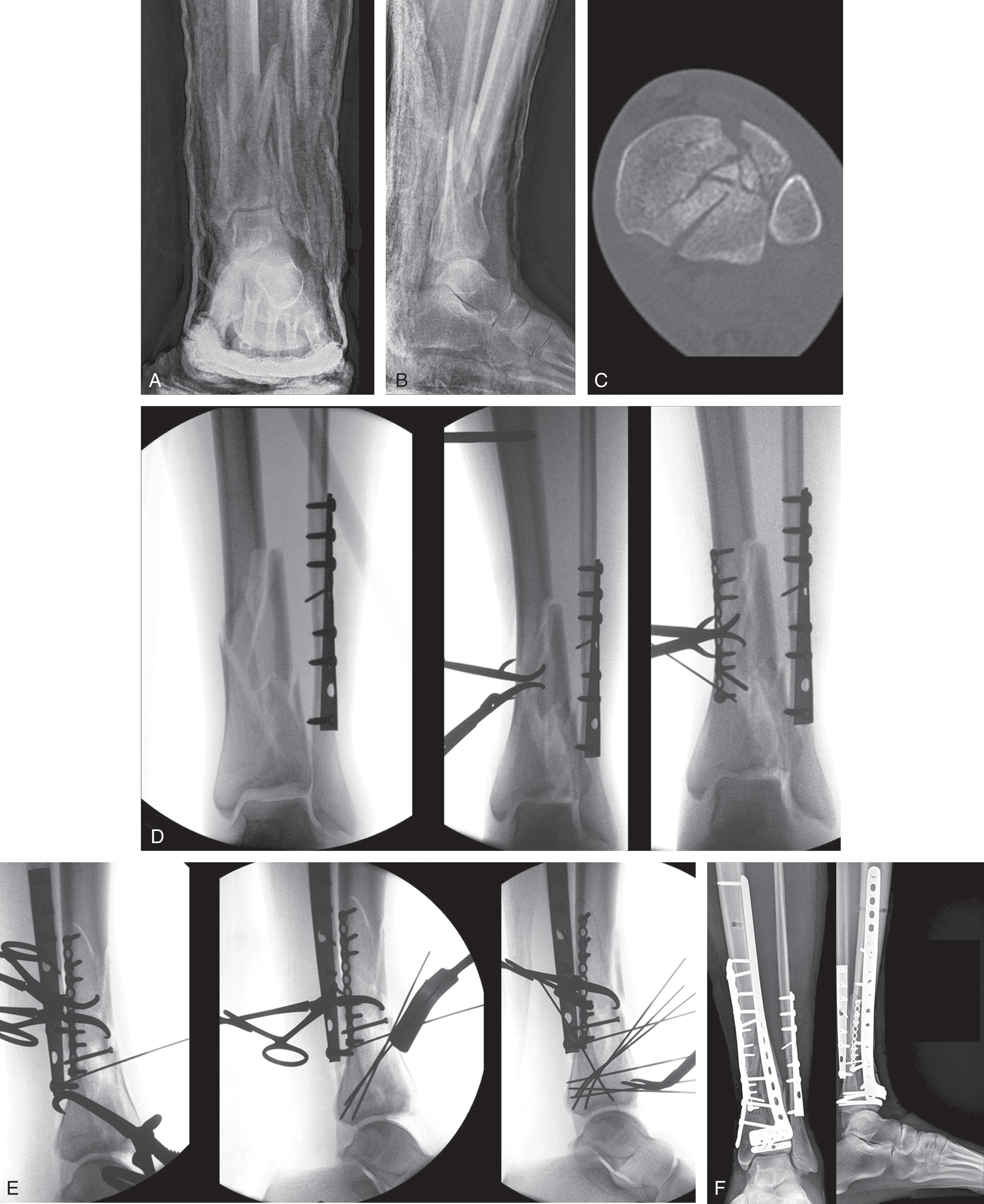
The use of an extensile posterior approach such as the posterolateral or posteromedial approach in C-type fractures is dependent on whether a reduction of the posterior malleolus (i.e., Volkmann fragment) can be obtained and maintained without direct reduction and plate application. Certainly, adding a posterior approach for reduction and fixation will almost always be possible and aid reduction, but there may be consequences, particularly if combining with an extensile anterior approach (e.g., anteromedial). At a minimum this is likely to include longer surgical time and need for repositioning. In theory, the longer surgical time and circumferential soft-tissue stripping may lead to a higher risk of infection, but this is controversial and not established in literature. Some authors have advocated for routine posterior approach as part of first-stage treatment with good results in small series. As an alternative to posterior exposure, there are a number of indirect reduction techniques that may be considered for the Volkmann fragment. These techniques will be discussed further in the section below on reduction strategies. Ultimately, the decision to employ posterior approaches for reduction and plate application is a critical part of the preoperative planning process that requires experience and judgement. Factors favoring the use of a posterior approach include greater displacement of the posterior malleolus, a relatively simple reduction read between the shaft and posterior malleolus (i.e., without segmental comminution), and a younger patient with a soft-tissue envelope that can tolerate a longer procedure with two extensile approaches. An algorithm for choosing a surgical approach is shown in Fig. 43-16 .
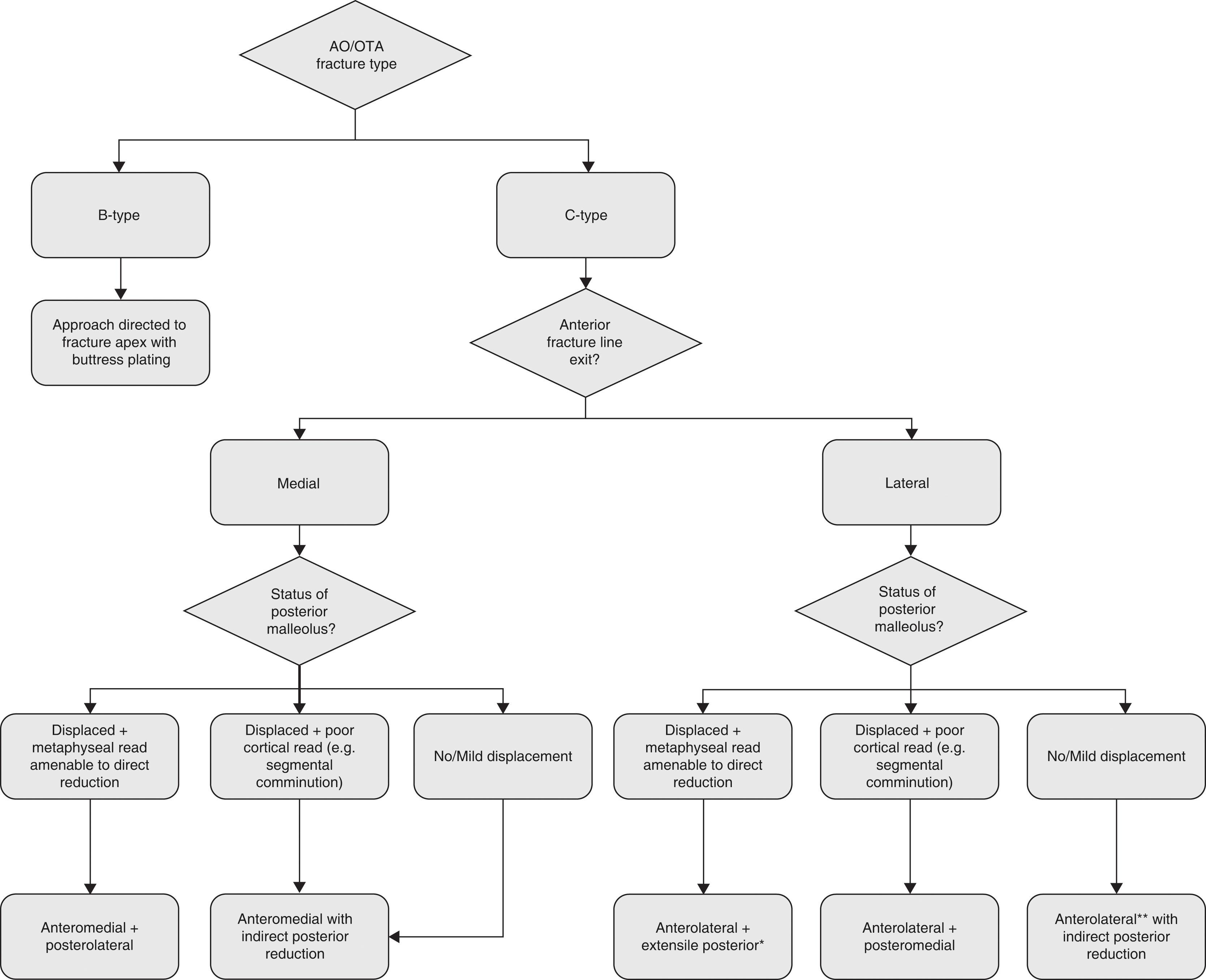
Of note, while the anteromedial approach provides the most extensile exposure with a single incision, it cannot be combined with a formal anterolateral or posteromedial approach due to the limited skin bridge afforded. Hence, the anteromedial approach is performed either in isolation or in combination with a posterolateral approach. In contrast, the anterolateral approach can be combined with a direct medial (typically for application of a medial buttress plate), a posteromedial approach, or a posterolateral approach. Historically a 7 cm skin bridge was advocated, but with modern staged treatment and less extensile exposures skin bridges of 5 to 6 cm are routine and do not negatively impact wound-healing outcomes.
Irrespective of the chosen approach, care should be taken to respect the soft-tissue envelope by using sharp dissection whenever possible and minimizing the use of self-retaining retractors.
Each major fragment has important ligamentous attachments, including the anterior tibiofibular ligaments (Chaput), posterior tibiofibular ligaments (Volkmann), and deltoid ligaments (medial malleolus), respectively. Care should be taken to preserve these important attachments both to maintain blood supply and restore stability to the tibiotalar joint after fixation. Lastly, a meticulous layered closure should be performed. Use of the Allgower-Donati technique with knots opposite the flap results in a robust, tension-free closure with the least impairment of skin perfusion.
The positioning of the patient will be dictated by the planned surgical approach. If a posterior approach is planned, prone positioning will afford optimal visualization, while the anterior approaches are best performed supine. An anterolateral approach can be combined with a posteromedial approach in supine position with external rotation of the limb, but posterior plate application is difficult unless the patient is positioned prone. Lateral positioning does allow simultaneous anteromedial and posterolateral approaches with external rotation, but an assistant is required, and imaging may be more challenging.
Depending on the quality of the reduction in the external fixator and positioning of bars relative to the planned exposure, the external fixator may be prepped into the field for the definitive procedure. This will assist with maintaining the length and alignment of the fracture during reduction and has been shown to have no negative consequences with regard to risk of infection provided the frame is thoroughly prepped with an alcohol-based solution. If the external fixator positioning or reduction is suboptimal, a distractor can be applied using a single pin in the tibia and a pin in the talus placed through the distal portion of the anterior incision. The distractor pins are placed medial to lateral in the case of an anteromedial approach and lateral to medial for an anterolateral approach. Because the vector of the distractor (talar pin anterior to ankle axis of rotation) results in a net plantarflexion moment compared to the delta frame (calcaneal pin posterior to ankle axis of rotation), it will frequently improve visualization of the articular surface to assess the reduction. Frequently, the frame or distractor will have to be relaxed for reduction of the medial malleolar fragment due to the pull on the deltoid ligament.
Become a Clinical Tree membership for Full access and enjoy Unlimited articles
If you are a member. Log in here